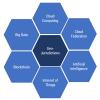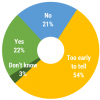Strategic advice to leverage new technologies
Technology is at the heart of nearly every enterprise, enabling new business models and strategies, and serving as the catalyst to industry convergence. Leveraging the right technology can improve business outcomes, providing intelligence and insights that help you make more informed and accurate decisions. From finding patterns in data through data science, to curating relevant insights with data analytics, to the predictive abilities and innumerable applications of AI, to solving challenging business problems with ML, NLP, and knowledge graphs, technology has brought decision-making to a more intelligent level. Keep pace with the technology trends, opportunities, applications, and real-world use cases that will move your organization closer to its transformation and business goals.
Recently Published
Artificial intelligence has many applications in supply chain and logistics. These range from automating the analysis and reporting on global supply chain activities and optimizing supply chain planning and execution to predictive applications for scheduling, strategic sourcing, and remote monitoring and predictive maintenance. This Advisor describes the major drivers for applying AI in the supply chain, including demand for greater visibility and transparency into supply chain data, processes, and execution, and a need to reduce risk and satisfy customer demands.
Generating Intelligent LOB Applications
Line-of-business (LOB) applications are at the center of most large enterprises. These are the applications we don’t think about and we don’t appreciate, but they’re the glue that keeps an organization functioning. They are the boring applications that drive internal processes, but the more LOB apps an enterprise has, the more technology it employs and the more productive it is.
Being hybrid is not new. Not at all. If we look around, we can see the entrenched old and the emerging new sitting side by side in our enterprises. And, in important instances, we have actually thought through, at some level, how the old and the new are tied together, thought of together, and managed together. If we do it right, we can build hybrids that allow us to have one foot in the present and one foot in the future, as we make our way across the skybridge to the new buildings of the future.
In this next-generation world of cloud computing, where the Internet of Things (IoT), artificial intelligence (AI), blockchain, edge computing, and cloud federation are enabling the vast deployment of innovative and resilient solutions, we must begin thinking more clearly about geo-jurisdictions. In this Advisor, we review three examples of how geo-jurisdiction policies and legislation can lead to dysfunctional businesses and economies.
Many organizations are now focusing on a hybrid cloud strategy: moving part of their IT capabilities to the cloud, while maintaining core elements in-house, hosted on-premises. The hybrid model is becoming immensely customary among organizations, as it enables them to optimally allocate their resources while keeping their current IT infrastructure operating at low risk. A hybrid cloud strategy not only prepares an organization for the future but also protects its investment today.
Given an established enterprise with its decades-old IT department, processes, and practices versus the accelerating marketplace — missing out on modern IT practices and being too rigid to react to market trends, and even putting innovation on half-yearly cycles — the hiring of a talented Agile architect can bridge the gap and lead the recently established digital pillar of the company. In this Advisor, we explore the common challenges the architect faces via the story of a day and propose building a “non-blocking” architecture governance practice for Agile development teams.
There is a lot of talk about how AI offers the possibility to transform how organizations operate. I am guilty of throwing around this type of statement myself. Of course, this brings up the all-important question: to what extent is AI currently transforming how organizations operate? Fortunately, the latest results from our ongoing survey examining the adoption and application of AI technology in the enterprise offer some insight into this question.
Recently, the Cutter Consortium editor who facilitates this Advisor series sent me a set of questions frequently asked about Agile transitions. Among the ones I found most intriguing wasn’t really a question but merely a statement, claiming: “Misunderstanding on the part of teams that Agile allows for less discipline, leading to less precise delivery schedules.” There are several elements of this statement that I encounter frequently, so I decided to use it as a basis for this article.















